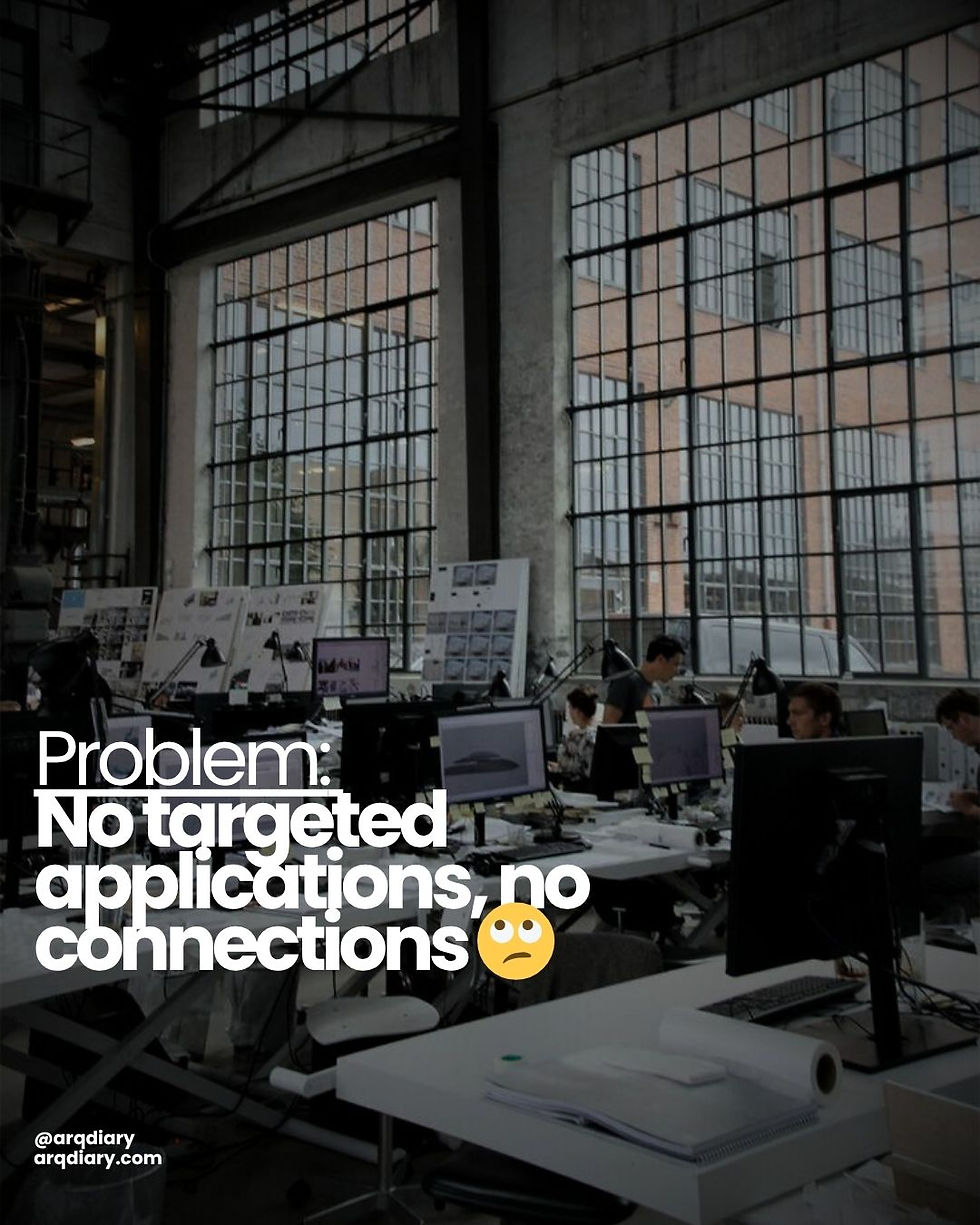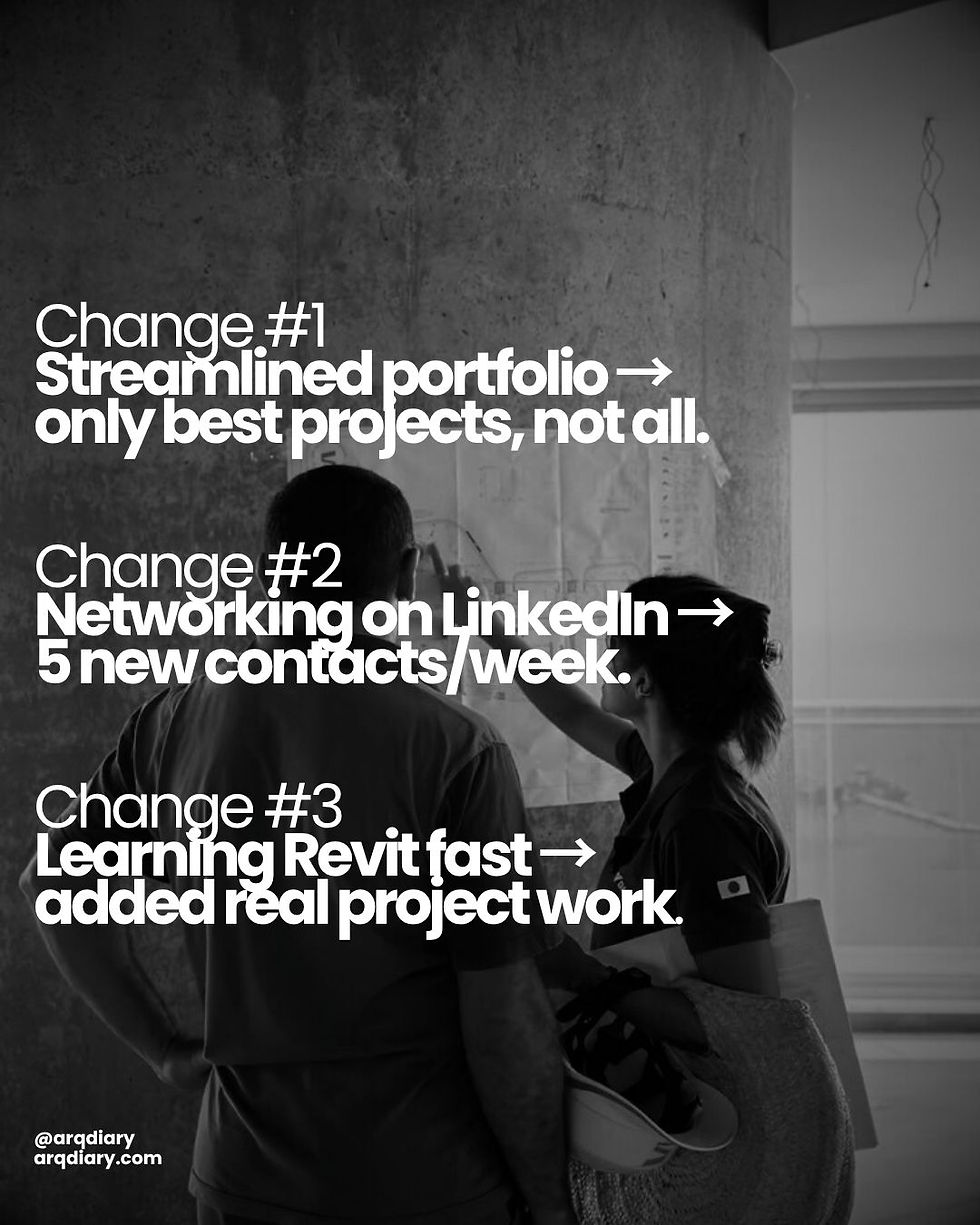Before & After: How I Landed My First Part 1 Role in 3 Months
- arqdiary

- Aug 13
- 5 min read
Intro My Starting Point + Challenges in applying for a role
Three months before my first architecture job offer, I was sending out generic CVs and bloated portfolios to dozens of firms — with a response rate of 0%. My applications felt busy but unfocused, and my LinkedIn profile didn’t even exist.
According to RIBA’s 2024 Graduate Survey, the average Part 1 job search takes 5–6 months, but I didn’t want to wait that long. The problem wasn’t my talent — it was my approach. Here’s the exact process I used to go from being ghosted to signing a contract in 90 days, without sending 100 scattershot applications.

Before Where I Was Going Wrong
At the start, my CV was two dense pages of text with minimal white space and far too much jargon. My portfolio was 25 pages long, yet only about 30% of the projects truly showcased my best abilities. Worse, 100% of my applications went to generic inboxes with no follow-up.
I also applied to over 20 firms in my first month without researching their style or values, resulting in zero interview invites. It was clear my documents weren’t connecting with busy recruiters who, according to industry data, spend less than 8 seconds scanning each CV on first pass.

Problem No Targeting, No Connections
The core issue wasn’t just design presentation — it was strategy. I was part of the 68% of graduates (RIBA 2024) who apply widely without targeting firms aligned to their skills. Without tailoring, my CV looked like it could have been sent to anyone, which made it easy to ignore. And without connections, my name never crossed a hiring manager’s desk outside of cold applications.
Statistically, referrals increase interview chances by up to 4x, yet I had none. My biggest realisation? Success in architecture job hunting is less about volume and more about visibility with the right people.

After What Changed?
When I started treating my job hunt like a design brief—conducting research, editing, and refining—the results changed quickly. I streamlined my portfolio to just 10 carefully selected pages, customised my CV for each position, and created a LinkedIn profile that began showing up in searches.
Networking became a regular part of my weekly routine, and I learned Revit in under six weeks. The difference was remarkable: I applied to only 14 firms in total but landed three interviews, giving me a 21% interview rate compared to 0% before. I wasn’t merely submitting applications anymore; I was establishing recognition even before my materials landed in the inbox.
Change #1 Streamlining My Portfolio
My portfolio used to be overloaded with 25 pages, inconsistent formatting, and included every project I had ever worked on. Given that hiring managers often review over 50 portfolios for each role, mine was exhausting to navigate. I decided to streamline it to 10 strong, varied projects, each showcased on a clean single page with clear captions and role descriptions.
I also made sure the PDF was under 15MB, which made it quick to open. After the changes, two out of three interviewers specifically mentioned how refreshing the concise layout was. A shorter portfolio not only saves time for recruiters but also demonstrates your ability to edit and present information clearly and purposefully.
Change #2 Networking on LinkedIn
Before this, I had no activity on LinkedIn. Within three months, I sent over 60 personalised connection requests—averaging about five per week—to alumni, visiting critics, and architects at my target firms.
My posts and thoughtful comments began reaching more people. One of the three interview invitations I received was directly from a connection I made just eight weeks prior. LinkedIn’s data shows that candidates with a strong network are 40% more likely to hear back from recruiters, and my experience reflected that. Networking didn't feel like "selling myself"; it felt like engaging in the professional conversation I wanted to be part of.
Change #3 Learning Revit Fast
Scanning 30+ job postings revealed that over 80% listed Revit as a required or preferred skill. I committed to learning it in under two months through a mix of LinkedIn Learning courses, YouTube tutorials, and peer mentoring.
I built a housing concept model and assisted a friend’s practice with a small Revit task, which gave me genuine project experience to show. In interviews, I could confidently say I’d used Revit on real work, not just “watched tutorials.” That credibility turned a common skill into a competitive edge — and helped tick a major requirement box for all three interviews.

Result 3 Interviews, 1 Offer in 3 Months
Before I made changes, my statistics were disheartening: I had a 0% interview rate from over 20 applications. After implementing some adjustments, I applied to just 14 firms, received 3 interview invitations (a 21% rate), and secured 1 offer — all within 90 days. This is half the average job-hunt time for a Part 1, according to RIBA’s latest figures.
Recruiters mentioned that they had seen my name on LinkedIn before my application reached their desk, and they found my concise portfolio made reviewing my work "a breeze." The key takeaway? A smaller, targeted approach is more effective than mass applications every time.
Recap You Can Do This Too
To enhance your professional image and improve your job search, consider narrowing your portfolio to your top 8 to 10 projects. Select the ones that best showcase your skills and the impressive results you've achieved. Each project should highlight a specific strength, making it easy for potential employers to understand what you can offer. Additionally, present these projects in a visually appealing and easy-to-navigate format—remember, first impressions are important!
As part of your networking strategy, aim to make at least five new LinkedIn connections each week. While this may seem small, it can significantly expand your network over time and lead to exciting opportunities. Engage with industry professionals, join groups that interest you, and participate in discussions to enhance your visibility and credibility. Additionally, familiarise yourself with the software and tools used by the companies you’re interested in. This demonstrates that you are proactive and prepared to adapt to their workflows.
If you're one of the 68% of graduates sending out applications like confetti, it might be time to switch gears. Try the targeted approach of the 32% who research companies and tailor their applications. Trust me, this strategy can lead to faster job placements. I cut my job search time nearly in half by focusing on a handful of companies that matched my goals and customising my application materials. This not only helped me stand out from the crowd, but it also increased my chances of landing interviews for positions that genuinely interest me—leading to way more job satisfaction in the long run.




Comments